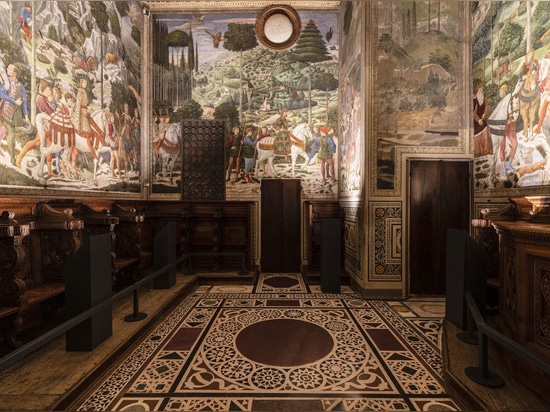
#Product Trends
Magi Chapel - Palazzo Medici-Riccardi, Florence
The precious heart of the Florentine Fourteen Hundreds
The Magi Chapel is a well kept secret on the noble floor of Palazzo Medici-Riccardi in Florence. Without windows or views, the chapel is like a pearl in a shell that still holds all the devotion, art and pride of a dynasty that has marked Italian culture from the fourteen hundreds to the present. A holy place where the confines of this extremely closed architecture are characterised by the austerity of the coro quattrocentesco, the carved and gold-painted ceiling and the floor with its Arabesque geometries. However, the true gem in these 40m2 remains the frescoes by Benozzo Gozzoli, pupil of Beato Angelico. On the three walls of the chapel, he describes the ride of the Magi in a parallelism with the procession of Pope Pius II Piccolomini arriving in Florence in April 1458. On the other hand, the altarpiece, positioned in the apse, holds a copy of the original Adorazione del Bambino by Filippo Lippi accompanied by worshipping angels facing the altar on the walls of the apse.
The goal of the work, in collaboration with the University of Florence, was to design a lighting system that could give new light to the Magi Chapel, an Italian artistic treasure from the Early Renaissance. For this small masterpiece of international importance, Linea Light Group provided its know-how in the preliminary verification stage to associate precise lighting with the various colour combinations, with any distortions and metamerisms and with the optical alterations in order to best free up the museum functions in its management.
The desire to improve the view, the fruition and the accessibility of the Magi Chapel expanded Linea Light Group’s field of action to chemistry, biology and archaeometry in favour of an all-around project for correct lighting and preservation of the space and the paintings. The extraordinary expressive peculiarities of the Benozzo palette and the need for new legibility of the frescoed surfaces led to the necessary decision to customise an ad hoc product for the museum. For a perfect view of the colours, constant colorimetric control and uninterrupted chromatic stability, the choice fell to the Optus LED projector. In a custom version, it has a fourfold essence as multi projector in seven different boxes positioned over the entire floor plan. The system also allows the diodes to be switched on and off through Bluetooth communication directly with all the Optus units on the perimeter in order to emphasise and better describe each aspect of this priceless and precious showcase. This product therefore also becomes an educational tool for the museum guides thanks to its dimming feature, allowing for a substantial improvement of how the works can be used.










